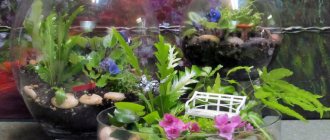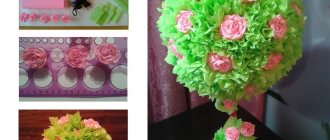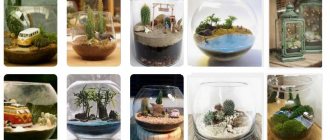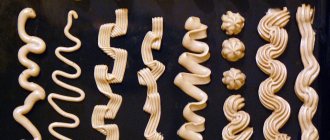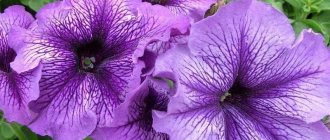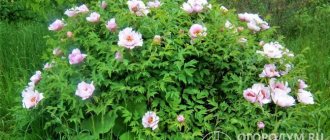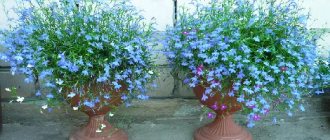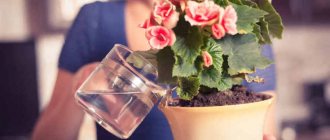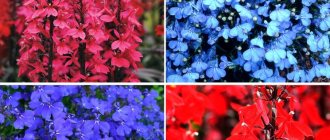A DIY florarium is an original craft. Make it yourself.
Terrarium or container. Another name is “bottle garden” or “flower arrangement in a glass container.” The florarium is used to create the design of rooms, small spaces and apartments.
Read another article on our website on the topic: “Aloe and agave are the same plant, what is the difference between them, comparison of succulents . You will learn what aloe and agave look like, and how and where they came from to our country, as well as the similarities and differences between the composition, care, medicinal properties, methods of using aloe and agave.
In this article we will tell you how to make a florarium with your own hands. It's actually simple. You will spend almost no money, but you will be able to create a unique interior decor. Read on.
Florarium: what is it?
Florarium
Florarium is a container for a flower arrangement made of glass or thick transparent plastic. To create a florarium, an aquarium or a glass vase of an unusual shape is suitable. They even use chemical flasks. Some craftsmen were able to adapt small test tubes and small glasses.
Florariums are used to grow plants that require special care: maintaining the necessary lighting, humidity and temperature. The container may have a round hole at the top or a narrow narrowed neck. Therefore, a certain microclimate is formed inside, without drafts and with a certain humidity. In such a container you can grow living plants or create artificial gardens.
Is it possible to plant and how to grow?
It is quite possible to plant an orchid in glass, observing a few simple rules: you should choose a plant suitable for planting (it must be healthy), a glass container of the correct shape, as well as good soil (as an option for a full-fledged balanced substrate for orchids, you can use Seramis soil) . After this, all that remains is to carefully control the watering.
Orchids are one of the most suitable plants for growing them in glass, especially if the air humidity in the room is not too high.
What crops can be planted when creating a florarium?
Various types of plants are suitable for growing in such a florarium container. Everything will depend on the conditions in which it will then be: a shaded room or a brightly lit room, cold or with a normal temperature. What crops can be planted when creating a florarium?
To avoid disappointment, novice florists should try growing unpretentious plants in containers - cacti, succulents or moss. If the room is poorly lit, plant ferns. In a well-lit area, try growing tropical and subtropical plants. They are not so fastidious to care for. Growing orchids requires some experience.
Suitable for florarium:
- Stem cacti and succulents - prickly pear, echinopsis, nonocactus, rebutia
- Crassulaceae - young, money tree, echeveria
- Mosses - sphagnum, pteris, multirow, asplenium
- Fern
- Dwarf Saintpaulias (violets)
- Different types of miniature fittonias
- Euphorbia croton
Sometimes up to ten different plants are placed in one garden.
What container is suitable for a florarium?
Container for florarium
For florariums, containers of various sizes and shapes are used. Which ones are suitable? But to successfully grow plants in this way, containers must meet the following requirements:
- Maintain moisture
Balls or vases with holes facing on the side prevent the evaporation of excess moisture. Aquariums, jars and other containers with a hole facing upward are more suitable for succulents and cacti that require little moisture. They can be divided into open and closed. Creating a composition in an open container is less problematic. To grow flowers in an open container of tropical plants, you should take care of the lid.
- Height matching
The container must contain all the necessary layers: drainage, soil and the plant itself. In order for the culture to develop freely, two-thirds of the free space should remain on top of the planted flowers.
- Light should penetrate well inside
For light to penetrate to plants, glass or plastic must be colorless - transparent.
You can plant a mini-garden in unusual vases, glass teapots, salad bowls and other containers. They are identified by their geometric shape:
- Round
- Cylindrical
- Square
- Custom-made containers
All containers can be classified by location:
- Wall mounted
- Tabletop
- Floor-standing
The most common are desktop options.
Types and suitable plants
The florarium can be open or closed. Closed is ideal for plants that like high humidity. It can be:
- Fittonia.
- Orchids (for example, phalaenopsis).
- Some varieties of begonias.
- Carnivorous plants (sundew, flycatcher).
- Bromeliads.
- Small Saintpaulias.
- Pellaea fern.
Photo gallery: flowers for an indoor florarium
Succulents are best suited for an open florarium:
Photo gallery: specimens for an open mini-garden
DIY florarium in a jar: step-by-step instructions, video
DIY florarium in a jar
Sometimes you can use improvised containers to create a florarium, for example, jars. The maximum volume of the container depends on the room in which you install it. There is a known case of using a 45 liter can. The sequence of actions will be approximately the same as that described above in the manufacture of other types of florariums.
Here are step-by-step instructions for performing a composition in a jar with your own hands:
- First prepare the container. Wash the jar well and dry.
- Wipe the inner surface with alcohol. This is how you should get rid of strongly visible palm prints on the glass.
- Do not use plexiglass products to create compositions; scratches appear on them and such glass begins to quickly become cloudy.
- Then you should decide on the plants that will be placed in the jar. Which ones you choose depends on the size of the jar.
It should be remembered : In the composition, select plants of the same growth rate, otherwise some species will block the light of others and interfere with their nutrition.
Then do the following:
- Determine the location where the mini-garden will be placed. The volume of the jar also depends on the location. Floor florariums have large volumes, wall florariums are small - up to a liter, tabletop florariums can be very different in size.
Lay out the drainage
- Place drainage at the bottom of the container: it can be coarse river sand, pebbles, pieces of small broken bricks or perlite.
Add activated carbon
- Place activated carbon on top of the drainage, which will remove excess moisture, bacteria and toxins.
- Cover both layers with a layer of earth, the total volume exceeding the layer of drainage and coal by two or even three times.
Lay out the soil
- For cacti and succulents, a mixture of sand and peat in a ratio of 1:2 , for mosses - ordinary turf soil, for other plants - soil suitable for the plants.
- Moisten the soil and leave for a while.
- Using tweezers, plant small plants or cacti, lay out moss (you can collect sphagnum yourself, somewhere in shaded places in the forest, plantings or parks).
- Carefully moisten the finished composition.
Plant the plants
- If you are planting moisture-loving plants such as ferns or tradescantia, close the jar with a lid. If they are cacti or succulents, you can leave them without a lid.
Place the jar in the intended place. Water this mini-garden no more than once a week. See the video below for more details.
How to decorate a room with your own hands without money - florarium with orchid: step-by-step instructions, video
Florarium with an orchid
If you need to liven up an interior that is already boring, then make a florarium. It will be especially good if you have blooming home flowers, for example, orchids. They can be used for a flower garden in an aquarium. Thanks to this approach, you can decorate a room with your own hands without money.
But remember that orchids and other flowering plants are very demanding of special conditions - temperature and humidity. Particular attention should be paid to their sizes. Large and tall flowers will require a large container. Small-growing and slow-growing species are often used. So, let's make a florarium with an orchid. Fittonias, mosses and ferns go well with this flower.
Here are the step-by-step instructions:
Florarium with orchid
- Prepare a glass container, this could be an unused aquarium, jars of different sizes, a decanter or a transparent glass teapot.
- Prepare the container for planting. Wash and wipe dry.
- If you have the desire and opportunity, make a geometric glass container using the Tiffany method. Instead of glass, you can use transparent plastic.
- Place drainage at the bottom of the container in a two to three centimeter layer. Sprinkle up to one centimeter of activated carbon on top.
- Level both layers and add soil, taking into account the type of orchid and what kind of soil it would be desirable to use. It is best to buy the required soil composition for the type used. You can put a layer of colored sand as a decorative insert.
- Place the orchid in the hole. If necessary, install a support for the peduncle. But be sure to make sure that the plant does not touch the walls of the vessel with its leaves. Otherwise, when humidity increases, the crop will rot and disappear.
- Water the florarium with orchids at the root, occasionally spraying. The substrate should be moistened after the surface has completely dried. This happens quite rarely in closed containers. In open ones, you need to constantly monitor the condition of the substrate.
- The temperature depends on the type of orchid.
A florarium with orchids should not be placed in direct sunlight. The leaves of the plants will get burned and the crop will die. For more information on how to make a florarium with an orchid, see the video below.
Features of growing in large vessels
For a container with a wide opening, you can use tools used to care for indoor plants.
Plants in transparent containers
Profusely flowering plants such as rhododendrons or azaleas, cyclamens, chameleon flowers or episcia, Usambara violets can rot in closed containers, so they are grown exclusively in large containers and often ventilated.
Drainage should occupy 1/3 of the entire soil. Apply a layer of soil about 3 cm on top, this depends on the height of the plant and the volume of the vessel.
Plants need to be periodically inspected and weeds removed. If the plants have grown too much, cut out unnecessary leaves and shoots. As a rule, after 1 year the plants are planted, and after 3 years the soil and the plants themselves are completely replaced. They are watered much less often than usual, since the air in the vessel is more humid than in the apartment.
DIY florarium with a waterfall: step-by-step instructions, video
DIY florarium with a waterfall
To make a mini-garden with a waterfall, you need to prepare:
- Large cylindrical vessel, flask or round aquarium
- A basin or bowl with a diameter slightly smaller than the diameter of the flask
- Transparent epoxy resin
- Acrylic paint of different colors
- Styrofoam pieces
- Liquid Nails
- Transparent plastic bottle
At first it may seem that making a florarium with a waterfall with your own hands is difficult and will not work. But this is not so, try it and create an interesting interior decor. Here are the step-by-step instructions:
- Place pieces of foam plastic in a basin or bowl in such an order to form a slide. The foam can be cut for complete authenticity, so that there is the appearance of a steep rock. Using a glue gun, fasten all the parts together, and secure with wooden skewers to be sure.
- Paint the “stones” in colors that match their natural ones. You can add green to imitate moss on the rocks. Cut the plastic bottle into small ribbons and secure it over the “stones”.
- Dilute the epoxy resin and pour it into the “pool” bowl.
- Apply some of the resin to the plastic strips to increase their volume and the natural appearance of the falling stream. The waterfall is ready. It can be placed in another vessel, or in a flask.
- Fill the bottom with pebbles or sand for drainage. Pour soil mixed with charcoal on top. We plant the selected plants.
Such mini-gardens, made with your own hands, will bring a lot of pleasure and will delight you on long winter days. To see how to make such a mini-garden, see the video below.
Artificial indoor florarium: what form to use, how to assemble it yourself, video
Artificial indoor florarium
The peculiarity of the closed florarium is that it is a self-sustaining system. Maintenance is kept to a minimum. It is watered only a couple of times a year. First, select a container. You can use a glass jar, bottle, or make a geometric container using the Tiffany method. Using such mini-gardens is an economical way to create a green indoor interior.
How to assemble it yourself? Perform step by step:
- Prepare the container. Wash and dry the jar or bottle. Disinfect if possible.
- Place the finished compost at the bottom of the vessel, and pour soil on top of it. You can also mix the soil with coffee grounds.
- Water the soil with enough water. And leave for a while until completely hydrated.
- Carefully plant the plant, making a hole in the soil with a spatula or stick.
- Water the top again using a small watering can, bottle or syringe. So that the stream of water does not erode the soil and roots of the plant.
- Place decorative elements nearby: marble “mountains”, ceramic figurines, houses.
- Close the container. Ready.
In closed florariums, you should choose plants that grow well at an air temperature of about +20°C , humidity of 60% and above, and do not suffer from lighting for 12 hours.
You can also make a completely artificial terrarium with an interesting composition. For example, using only sand, artificial flowers, various figures and objects, you will get excellent interior decor. It does not need to be looked after like a composition with fresh flowers, but in beauty it is in no way inferior. See the video below for more details.
Popular compositions
You can create almost any composition in a glass container, but a full-fledged aquarium is still considered the optimal container, since it is equipped with lighting and a removable lid. As the succulents grow, a separate ecosystem is organized inside, which does not require intervention.
In addition to aquariums, jars, decanters, bottles, glasses, and other vessels are used. They can be purchased specifically for organizing a florarium, or you can use improvised means.
Desert
To reduce the time required to care for the composition, select types of succulents that do not require care. A florarium made of desert-themed cacti is an excellent solution for a small windowsill or desktop.
An open aquarium, a jar, a round decanter with a narrow neck, a candy dish and glass vases are used as containers. The main desert theme is set by sand:
- colored, which can be poured in layers, vertical stripes or in a chaotic manner;
- small river or sea;
- a mixture of light sand and dark pebbles.
As additional decoration, use stones (preferably rounded ones) and ceramic chips.
Forest
You can create a composition in the form of a tropical forest by planting tall plants in the background and short plants in the foreground. It is necessary to place succulents in such a way that all tiers are visible. Select heat-loving trees, and the most common ones will do - ferns, ficus, asparagus, small cacti, common ivy. Consider everyone’s requirements for soil, which can be used as leaf soil, peat with the addition of sand.
To create an ideal microclimate inside the florarium, place a small container of water or, if volume allows, an artificial waterfall.
Mountains
To convey the mountain atmosphere as much as possible, plant plants whose homeland is forest foothills or rocky terrain:
- succulents, including cacti;
- ferns;
- Saintpaulia;
- ivy.
Choose trees with the same requirements for climate, soil, humidity and light levels. When planted in a container larger than 7–10 liters, the florarium’s own microclimate is created.
